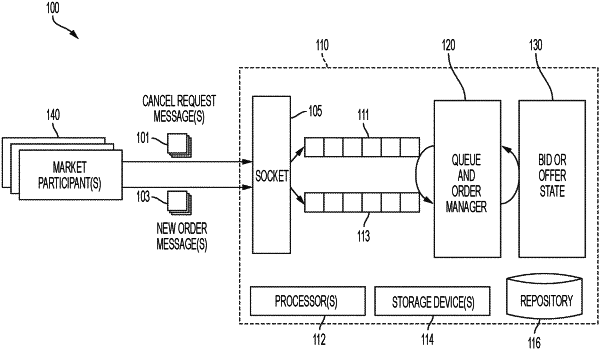| CPC G06Q 40/04 (2013.01) | 28 Claims |

|
1. A computer-implemented method of maker orders including cancel delay values for execution on an Electronic Trading Venue (ETV), wherein the cancel delay values prevent cancellation of maker orders for a defined time period such that particular maker orders submitted by market participants with network connections with the ETV of a first speed may not be cancelled before completion of a matching operation with taker orders submitted by market participants with network connections with the ETV of a second speed slower than the first speed, and maker orders with cancel delay values of a first value are prioritized over maker orders with cancel delay values of a second value less than the first value to incentivize the use of the larger cancel delay values and increase the fairness and systemic efficiency of the ETV, the method being implemented by a computer system having one or more physical processors programmed with computer program instructions that, when executed by the one or more physical processors, program the computer system to perform the method, the method comprising:
storing, by the computer system, a first implicit cancel delay value associated with a first market participant;
receiving, by the computer system, a plurality of messages from market participants;
adding, by the computer system, a timestamp to individual messages of the plurality of messages indicating a time of receipt of the individual messages by the ETV;
analyzing, by the computer system, the payload of the individual messages of the plurality of messages and classifying, based on their payload, the individual messages as a maker order, a taker order, or a cancel request message;
adding, by the computer system, maker orders to a maker order queue, taker orders to a taker order queue, and cancel requests to a cancel request queue, the maker orders comprising a first maker order sent by the first market participant comprising an order to buy or sell an instrument at a price level and a second maker order sent by a second market participant comprising an order to buy or sell the instrument at the price level;
ordering, by the computer system, the maker order queue, taker order queue, and cancel request queue by the time of receipt by the ETV of the maker orders, taker orders, and cancel requests, respectively;
determining, by the computer system, whether the first maker order includes a first explicit cancel delay value;
obtaining, based on the determination that the first maker order does not include a first explicit cancel delay value, the first implicit cancel delay value, and associating the first implicit cancel delay value to the first maker order, the first implicit cancel delay value comprising a first amount of time that must pass from the receipt, by the ETV, of a request to cancel the first maker order during which the ETV is prevented from canceling the first maker order;
obtaining, by the computer system from the cancel request queue, a first cancel request from the first market participant that requests cancellation of the first maker order for the instrument;
identifying, by the computer system, the first maker order as corresponding to the first cancel request and, in response, obtaining a current time;
determining, by the computer system, that the first amount of time in the first implicit cancel delay value has not passed by comparing the first implicit cancel delay value with the amount of time that has passed between the current time and the time stamp added to the first cancel request indicating the time of receipt of the first cancel request by the ETV;
preventing, by the computer system and in response to the determination that the first amount of time in the first implicit cancel delay value has not passed, the first maker order from being cancelled at the current time;
obtaining, by the computer system, a second cancel delay value associated with the second maker order by the second market participant, the second cancel delay value comprising a second amount of time that must pass from the receipt, by the ETV, of a request to cancel the second maker order during which the ETV is prevented from canceling the second maker order, the second amount of time being different than the first amount of time of the first cancel delay value associated with the first maker order;
determining, by the computer system, that the second cancel delay value is larger than the first implicit cancel delay value;
ranking, by the computer system and in response to the determination that the second cancel delay value is larger than the first implicit cancel delay value, the second maker order ahead of the first maker order;
obtaining, by the computer system from the taker order queue, a taker order for the instrument; and
selecting, by the computer system and in response to the ranking of the second maker order ahead for the first maker order, the second maker order to be matched with the taker order for execution despite the ordering of the first and second maker orders in the maker order queue.
|